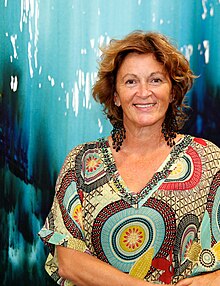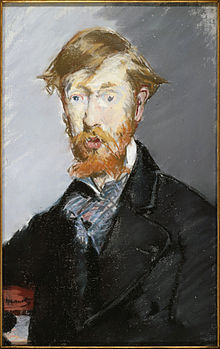Portal:The arts
T H E A R T S P O R T A L
The arts are a very wide range of human practices of creative expression, storytelling, and cultural participation. They encompass multiple diverse and plural modes of thinking, doing, and being, in an extremely broad range of media. Both highly dynamic and a characteristically constant feature of human life, they have developed into innovative, stylized, and sometimes intricate forms. This is often achieved through sustained and deliberate study, training, and/or theorizing within a particular tradition, across generations, and even between civilizations. The arts are a vehicle through which human beings cultivate distinct social, cultural, and individual identities while transmitting values, impressions, judgements, ideas, visions, spiritual meanings, patterns of life, and experiences across time and space.
Prominent examples of the arts include:
- visual arts (including architecture, ceramics, drawing, filmmaking, painting, photography, and sculpting)
- literary arts (including fiction, drama, poetry, and prose)
- performing arts (including dance, music, and theatre)
They can employ skill and imagination to produce objects and performances, convey insights and experiences, and construct new environments and spaces.
The arts can refer to common, popular, or everyday practices as well as more sophisticated, systematic, or institutionalized ones. They can be discrete and self-contained or combine and interweave with other art forms, such as the combination of artwork with the written word in comics. They can also develop or contribute to some particular aspect of a more complex art form, as in cinematography. By definition, the arts themselves are open to being continually redefined. The practice of modern art, for example, is a testament to the shifting boundaries, improvisation and experimentation, reflexive nature, and self-criticism or questioning that art and its conditions of production, reception, and possibility can undergo.
As both a means of developing capacities of attention and sensitivity and as ends in themselves, the arts can simultaneously be a form of response to the world and a way that our responses and what we deem worthwhile goals or pursuits are transformed. From prehistoric cave paintings to ancient and contemporary forms of ritual to modern-day films, art has served to register, embody, and preserve our ever-shifting relationships to each other and to the world. (Full article...)
Featured articles -
Featured picture
Did you know...
- ... that Aythorpe Roding Windmill (pictured) is the largest surviving post mill in Essex, England?
- ... that Bill Flemming called over 600 events as a broadcaster for the ABC Sports' Wide World of Sports during his career?
- ... that the 1994 French–Romanian film An Unforgettable Summer depicts the persecution of Bulgarians by Romanian Army personnel, in a metaphor of the Yugoslav wars?
In this month
- 2 November 1906 – Italian theatre, opera and film director Luchino Visconti, whose films include The Leopard and Death in Venice, was born in Milan
- 15 November 1887 – Influential American artist Georgia O'Keeffe (pictured) is born near Sun Prairie, Wisconsin
- 20 November 1910 – Russian novelist Leo Tolstoy, author of War and Peace and Anna Karenina, dies of pneumonia at the Astapovo train station
- 21 November 1945 – Sergei Prokofiev's ballet Cinderella premieres at the Bolshoi Theatre in Moscow with Galina Ulanova in the title role
- 27 November 1880 – Rome's main opera house, the Teatro Costanzi, is officially inaugurated with a performance of Rossini's Semiramide
News
- August 5: DaBaby Levitating remix losing US radio audiences after the rapper's comments on HIV/AIDS
- June 11: Taylor Swift's Evermore records biggest sales week of the year as it returns to No 1 on album chart
- May 27: Olivia Rodrigo's song good 4 u debuts at No 1 on US Billboard Hot 100 chart
- May 25: 'Rock and roll never dies': Italy wins Eurovision after 30 years
- February 10: Disney to shut down Blue Sky Studios, animation studio behind 'Ice Age'
Featured biography
Roman Vishniac was a Russian-American photographer, best known for capturing on film the culture of Jews in Eastern Europe before the Holocaust. He was, however, an extremely diverse photographer, an accomplished biologist and a knowledgeable student and teacher of art history. Throughout his life, he made significant scientific contributions to the fields of photomicroscopy and time-lapse photography. He later became a teacher and collector of historic art and artifacts.
Vishniac was very interested in history, especially that of his ancestors. In turn, he was strongly tied to his Jewish roots and was a Zionist later in life. Roman Vishniac won international acclaim for his photography: his pictures from the shtetlach and Jewish ghettos, celebrity portraits, and images of microscopic biology. He is known for his book A Vanished World, published in 1947, which was one of the first such pictorial documentations of Jewish culture in Eastern Europe from that period. He is known also for his extreme humanism and respect and awe for life, sentiments that can be seen in all aspects of his creation and his work. (Full article...)
Featured audio
Selected quote
Categories
WikiProjects
Parent project
Descendant projects
Related portals
Things you can do
- Check the recent changes page for improvements, other changes, and vandalism to these articles
- Article requests: Requests articles (arts and entertainment)
- Deletion discussions: Listed at Wikipedia:WikiProject Deletion sorting/Arts
- Expand: check Visual arts stubs to expand
- Notability: Articles with notability concerns, listed at WikiProject Notability
- Requested pictures: Arts topics, requested pictures


























